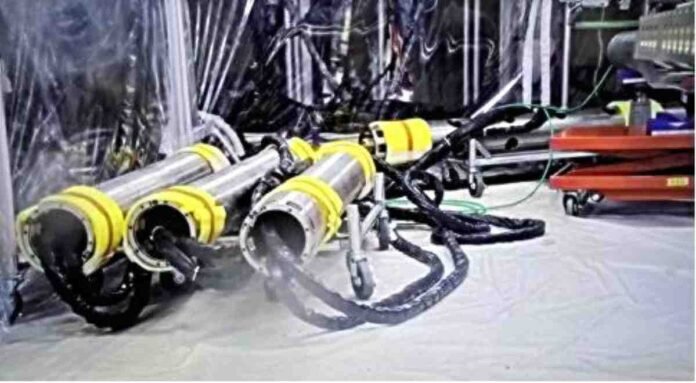The pipes that TEPCO wanted to use for the test to remove nuclear fuel residues from reactor 2 of the Fukushima 1 nuclear power plant were installed in the wrong order on Thursday.
16:50 JST, August 23, 2024
A fundamental flaw has halted the test to remove melted nuclear fuel residue from the Fukushima No. 1 nuclear power plant before the process could even begin.
Tokyo Electric Power Company Holdings, Inc. has suspended work to take a sample of debris from the nuclear plant’s No. 2 reactor, which was set to begin Thursday, after an error was discovered during preparatory procedures for the delicate operation. The government and TEPCO aim to complete the plant’s decommissioning by 2051, and the removal of the debris was billed as the start of a new phase in that process.
“Removing debris is the most important task in the decommissioning process and must be done in a precise manner,” TEPCO President Tomoaki Kobayakawa told reporters Thursday morning after being informed of the suspension. “Rather than causing a big problem by rushing, it is important to carry out the operation safely.”
The test extraction would have used a fishing rod-like device that can be up to 22 meters long and has a claw on the end to collect up to 3 grams of debris. On the first day of the procedure, TEPCO intended to open a valve that prevents radioactive materials from escaping from the reactor vessel, and then insert the device into the vessel. Although the valve was opened, a worker noticed that five lines that would be connected to push the device into the vessel were placed in the wrong order, with the first line where the fourth line should have been. TEPCO subsequently suspended the test extraction.
The pipes had numbers written on them in characters about 2 inches square to prevent them from being connected incorrectly. The installation of the pipes was completed on Wednesday, but no one noticed that there had been a mistake in the order of the pipes.
If extraction had been successfully initiated, the government and TEPCO would have moved the decommissioning process into the third and final phase.
“The operation of the device had been checked in a separate facility, so we were confident that the process would be successful,” a government official said dejectedly. “This development was unexpected.”
Crucial work
Meltdowns occurred at reactors 1 through 3 of the Fukushima Daiichi No. 1 nuclear power plant after the Great East Japan Earthquake on March 11, 2011. Nuclear fuel mixed with concrete and other materials in the reactors and solidified into debris. An estimated 880 tons of debris remains in the three reactors. This debris radiates heat, is extremely radioactive, and would be fatal to people exposed to it. Removing this debris is the core of the decommissioning process.
Making progress in removing the debris would reduce the amount of water that becomes contaminated with radioactive materials when it is used to cool the inside of the reactors. It would also reduce the plant workers’ exposure to radiation.
Reactor No. 2 was selected for the debris cleanup test because it was not affected by a hydrogen explosion in the 2011 disaster and the damage was less severe than at the other reactors.
Once the debris is removed, it is taken to the Oarai Research and Development Institute of the Japan Atomic Energy Agency in Ibaraki Prefecture for careful examination. For example, learning the hardness of the debris is relevant to the selection of equipment and methods to effectively remove more of it. Determining the composition of the debris will also aid efforts to determine safe disposal methods.
“If just a few grams can be analyzed, it is possible to estimate the temperature inside the reactors at the time of the 2011 accident and other details,” said Yasuaki Miyamoto, director general of the agency’s Fukushima Research and Engineering Institute. “That should help to significantly speed up the decommissioning work.”
However, the distribution and meltdown of nuclear fuel differs per reactor. It is therefore still unclear to what extent an analysis of the debris from reactor 2 is useful for reactors 1 and 3.
A flood of problems
A TEPCO official regretted the situation that led to the extraction being suspended on Thursday. “It was a fundamental mistake,” the official said.
Since the fall of 2023, a series of problems have occurred at the same nuclear power plant, including a power outage and contaminated workers. In October 2023, two workers cleaning equipment for the purification of contaminated water were accidentally splashed with liquid waste containing radioactive materials. Both workers had to be hospitalized.
In May and June, TEPCO fully investigated about 1,000 operations related to the decommissioning and completed the review of procedures for about 680 of them. Nevertheless, the debris clearance stumbled at the first step.
Prof. Hiroshi Yamagata of Nagaoka University of Technology, an expert in system security, indicated that improvements are possible.
“Errors can be reduced by allowing sufficient time to do this work, and by ensuring that workers are properly trained and given sufficient information,” Yamagata said. “Decommissioning the reactors will be a long road. TEPCO must do everything it can to ensure that such an environment exists at the nuclear power plant.”



